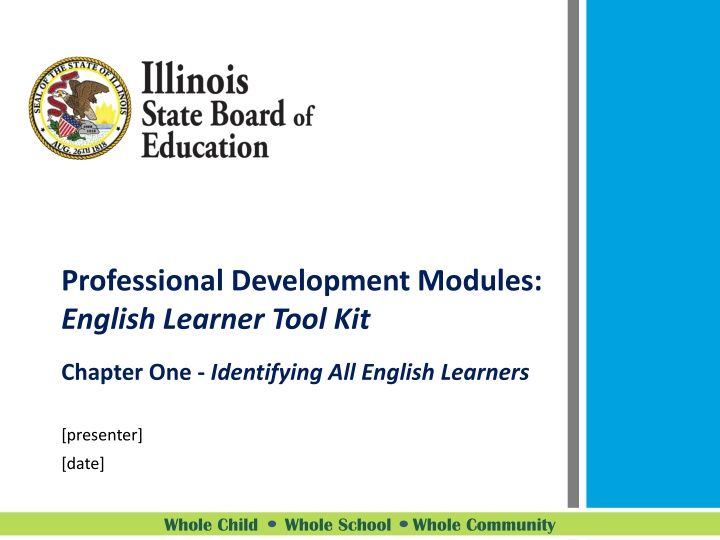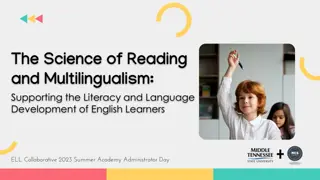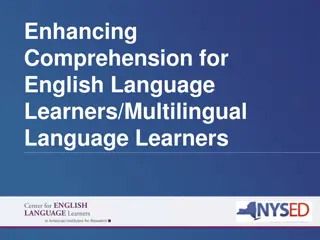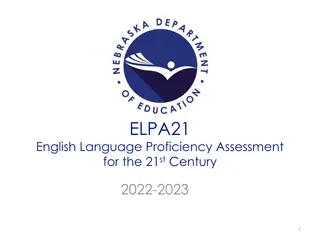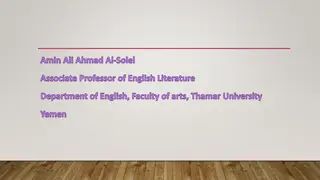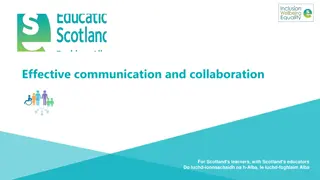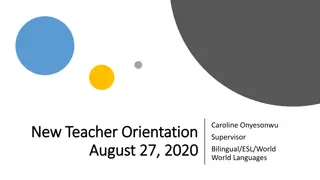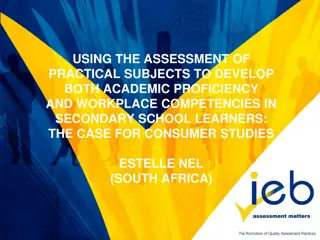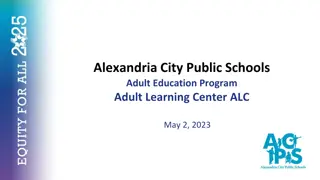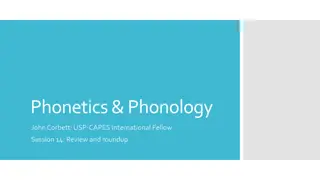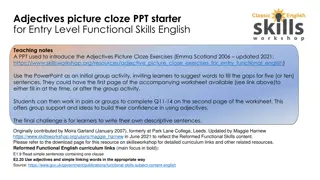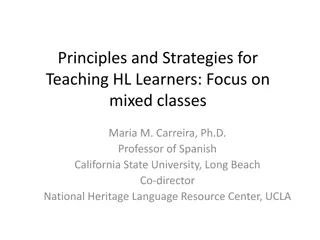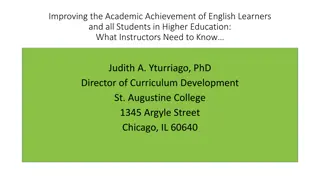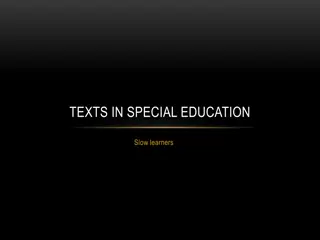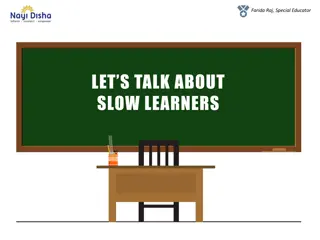Comprehensive Guide to Supporting English Learners in Education
This comprehensive guide outlines the importance of identifying and supporting English learners (ELs) in educational settings, covering legal obligations, best practices, and historical court cases that have shaped policies. The guide emphasizes creating inclusive environments, providing language assistance, and fostering meaningful access for EL students, parents, and families.
Download Presentation

Please find below an Image/Link to download the presentation.
The content on the website is provided AS IS for your information and personal use only. It may not be sold, licensed, or shared on other websites without obtaining consent from the author.If you encounter any issues during the download, it is possible that the publisher has removed the file from their server.
You are allowed to download the files provided on this website for personal or commercial use, subject to the condition that they are used lawfully. All files are the property of their respective owners.
The content on the website is provided AS IS for your information and personal use only. It may not be sold, licensed, or shared on other websites without obtaining consent from the author.
E N D
Presentation Transcript
Professional Development Modules: English Learner Tool Kit Chapter One - Identifying All English Learners [presenter] [date] Whole Child Whole School Whole Community
Purpose The Professional Development Modules: English Learner Tool Kitis a series of presentations intended to provide guidance to help local educational leaders meet their legal obligations to English learners (EL) and enhance existing EL practices to meet the needs of all EL students, parents, and families. Whole Child Whole School Whole Community Whole Child Whole School Whole Community
English Learner Tool Kit Topics 1. Identifying All ELs 2. Language Assistance Programs 3. Staffing and Supports 4. Meaningful Access 5. Inclusive Environment 6. ELs with Disabilities 7. ELs Who Opt Out of Programs 8. Monitoring and Exiting EL Programs 9. Evaluation of EL Programs 10.Communication with EL Parents Whole Child Whole School Whole Community Whole Child Whole School Whole Community
Significant Legal History Title VI of the Civil Rights Act, 1964 Prohibits discrimination on the grounds of race, color, or national origin by recipients of federal financial assistance. The Title VI regulatory requirements have been legally interpreted to prohibit denial of equal access to education because of a language minority student's limited proficiency in English. Whole Child Whole School Whole Community Whole Child Whole School Whole Community
Significant Legal History Lau v. Nichols Court Case, 1974 Case dealt with San Francisco school system s failure to provide English language instruction to 1,800 students of Chinese ancestry. U.S. Supreme Court unanimously ruled that a lack of supplemental instruction for English learners denies them a meaningful opportunity to participate in educational programs, which violates the Civil Rights Act of 1964. Whole Child Whole School Whole Community Whole Child Whole School Whole Community
Significant Legal History Equal Educational Opportunities Act (EEOA), 1974 Prohibits states from denying equal educational opportunity to an individual on account of his or her race, color, sex, or national origin. The statute specifically prohibits states from denying equal educational opportunity by the failure of an educational agency to take appropriate action to overcome language barriers that impede equal participation by its students in its instructional programs. Whole Child Whole School Whole Community Whole Child Whole School Whole Community
There is no equality of treatment merely by providing students with the same facilities, textbooks, teachers, and curriculum; for students who do not understand English are effectively foreclosed from any meaningful education. Justice William Douglas
Legal Obligations U.S. Department of Education s Office of Civil Rights (OCR) and the U.S. Department of Justice (DOJ) share enforcement authority. Issued joint guidance in 2015 to help states, districts, and schools meet legal obligations to ELs. Guidance identifies 10 common civil rights issues for English learners. Whole Child Whole School Whole Community Whole Child Whole School Whole Community
Identifying All English Learners Whole Child Whole School Whole Community Whole Child Whole School Whole Community
ENGLISH LEARNER TOOLKIT Chapter 1 7 Whole Child Whole School Whole Community Whole Child Whole School Whole Community
KEY POINTS: LEAs must identify in a timely manner EL students in need of language assistance services. The home language survey (HLS) is the most common tool used to identify potential ELs. An HLS must be administered effectively to ensure accurate results. Whole Child Whole School Whole Community Whole Child Whole School Whole Community
Illinois Specific Guidance on Identifying All English Learners Whole Child Whole School Whole Community Whole Child Whole School Whole Community
Two critical steps in the identification of English learners 1. Districts shall administer a Home Language Survey (HLS) for every student enrolling in a public school. 2. Districts shall administer an individual screener for English language proficiency to each student identified as a potential English learner through the HLS. Whole Child Whole School Whole Community Whole Child Whole School Whole Community
Illinois Example Home Language Survey The State requires the district to collect a home language survey for every new student. This information is used to count the students whose families speak a language other than English at home. It also helps to identify the students who need to be assessed for English language proficiency. Please answer the questions below and return this survey to your child s school. Student name: ______________________________ 1. Is a language other than English spoken in your home? What language? ________________________ Yes ___ No ___ 2. Does your child speak a language other than English? What language? ________________________ Yes ___ No ___ If the answer to either question is yes, the law requires the school to assess your child s English language proficiency. ________________________________ Parent/Guardian Signature _________________ Date Whole Child Whole School Whole Community Whole Child Whole School Whole Community
Home Language Survey Process The HLS is to be completed by the parents/guardians of all students entering a school district in a language they understand Answer is Yes to either question on the HLS: Student is a potential EL Answer is No to both questions on the HLS: Student is not a potential EL Conduct ISBE prescribed screener for English language proficiency and notify parents of the results within 30 days No screening for English language proficiency required Whole Child Whole School Whole Community Whole Child Whole School Whole Community
Preschool English Proficiency Screening ISBE recommends the use of Ballard & Tighe s Pre-IPT Oral for assessing English language proficiency (ELP) in preschool for children ages 3 and up Preschool screening for ELP procedures: Consult familyon child s English language experience Be culturally and linguistically appropriate Be age and developmentally appropriate Be research-based Include multipleobservations Use multiple measures and methods Be conducted by qualified staff with background in preschool education and second-language acquisition Whole Child Whole School Whole Community Whole Child Whole School Whole Community
K-12 English Proficiency Screening Minimum Score for English Proficiency Required Screening Domains Included Grade Listening Speaking Kindergarten semester 1 5.0 oral composite WIDA MODEL Listening Speaking Reading Writing Listening Speaking Reading Writing Kindergarten semester 2 1st grade semester 1 5.0 overall composite + 4.2 literacy WIDA MODEL 1st grade semester 2 12th grade 5.0 overall composite WIDA Screener Whole Child Whole School Whole Community Whole Child Whole School Whole Community
ELP Screening Exceptions ACCESS for ELLs results for the previous school year are available Screening results from within last 12 months are available Exceptions Student previously demonstrated proficiency on screener or ACCESS for ELLs Student was previously not identified as an EL and met reading + math standards on most recent state or nationally normed assessment Whole Child Whole School Whole Community Whole Child Whole School Whole Community
After the ELP Screening If a student meets ELP criteria on the screener, EL services/program are not required. The parents should be informed of the screening results. Whole Child Whole School Whole Community Whole Child Whole School Whole Community
Placement Notification Letter in English and student shome language Sent within 30 days of beginning of school year or 14 days of enrollment Explain how the EL program will support the student Notification of the right to withdraw student from the program or choose different EL services, if offered Whole Child Whole School Whole Community Whole Child Whole School Whole Community
Pause and Reflect What is our district/school s current process for identifying English learner students, including preschool students? What is our district/school s current process for notifying families of EL placement? In what ways do our processes meet all state requirements? Beyond the legal requirements, how might our processes be made more clear and supportive for students and families? Whole Child Whole School Whole Community Whole Child Whole School Whole Community
22 ADDITIONAL RESOURCES TO CONSIDER FROM THE EL TOOLKIT Whole Child Whole School Whole Community Whole Child Whole School Whole Community
23Identification Tools Home Language Surveys Home Language survey examples help the LEA ensure that all students receive the education services they need. Whole Child Whole School Whole Community Whole Child Whole School Whole Community
Background Resources Fact sheet on the responsibilities of school districts Fact sheet answering common questions about the rights of limited English proficient parents and guardians Original OCR/DOJ guidance in Dear Colleague letter Translations into multiple languages All available at https://www2.ed.gov/about/offices/list/ocr/ellresources.h tml Companion toolkit from the Dept. of Education Office of English Language Acquisition: https://www2.ed.gov/about/offices/list/oela/english- learner-toolkit/index.html Whole Child Whole School Whole Community Whole Child Whole School Whole Community
Identification Resources Illinois home language survey examples and translations: https://www.isbe.net/Pages/English-Learners-Forms-and-Notifications.aspx Illinois notification letter examples and translations: https://www.isbe.net/Pages/Parent-Notification-of-Enrollment- Requirements.aspx Further Reading Abedi, J. (2009). English language learners with disabilities: Classification, assessment, and accommodation issues. Journal of Applied Testing Technology: http://www.testpublishers.org/assets/documents/Special%20issue%20article%202.pdf. Bailey, A. (2011). Lessons from AZ s EL identification issues: How guidance could strengthen process. NCLB Advisor: http://eveaproject.com/doc/A%20%20Bailey%27s%20Piece%209_26_11%20SO.pdf. Bailey, A. and Kelly, K. (2010). ELPA Validity Evaluation: Creating Enhanced Home Language Survey Instruments. Retrieved from http://www.eveaproject.com/doc/HomeLanguageSurveyInstrument.pdf. Whole Child Whole School Whole Community Whole Child Whole School Whole Community
